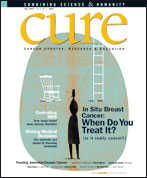Publication
Article
CURE
Multiple Myeloma & Leukemia
Author(s):
Drugs for multiple myeloma and CML reach patients.
Six months after its approval for myelodysplastic syndromes, Revlimid® (lenalidomide) was approved in late June for patients with multiple myeloma whose disease progressed despite prior therapy. Multiple myeloma, the second most common blood cancer, will be diagnosed in about 16,000 Americans in 2006. Caused by a cancerous growth of plasma cells that can cause damage to bone tissue, multiple myeloma can cause bone pain, fractures, kidney failure, anemia and an increased risk of infection.
The approval was based in part on positive results from a large study with myeloma patients whose disease was either unresponsive to previous chemotherapy or relapsed after first-line chemotherapy treatment. Revlimid, an oral drug taken daily, combined with the steroid Decadron (dexamethasone), increased overall survival when compared with patients who received Decadron alone. Half the patients on the Revlimid arm lived longer than 30 months compared with 20 months for the Decadron-alone arm. The main side effects of Revlimid are a decrease in white blood counts, anemia and fatigue.
Revlimid is currently available through a restricted distribution program called RevAssist, which requires doctors and pharmacists to register in order to prescribe the drug. For more information on Revlimid, visit www.revlimid.com.
An estimated 4,500 people will be diagnosed in 2006 with chronic myeloid leukemia (CML), a disease caused by an overgrowth of white blood cells in the bone marrow and peripheral blood. Characterized by a chromosomal abnormality called the Philadelphia chromosome, CML cells produce an abnormal protein that is now considered the principle cause of the disease.
Although Gleevec (imatinib) is effective in most CML patients, it is estimated that 4 percent of newly diagnosed CML patients do not respond to Gleevec, and up to 20 percent of patients may either not be able to tolerate Gleevec due to side effects or develop resistance to Gleevec over time. The risk of resistance increases with the number of years the patient received prior treatment and severity of the disease. Patients with advanced CML or a rare form of acute leukemia called Philadelphia chromosome-positive acute lymphoblastic leukemia (ALL) generally develop resistance more rapidly.
Two new drugs have helped fill the void in Gleevec-resistant CML. In June, data from several studies were considered positive enough for the Food and Drug Administration to grant accelerated approval to Sprycel (dasatinib) for CML patients with a resistance or intolerance to Gleevec or other CML therapies. Now in phase III testing for CML, an earlier trial comparing Sprycel with high-dose Gleevec found more patients responded to Sprycel, and for a longer period of time, compared with Gleevec. The FDA also granted full approval of Sprycel for Philadelphia chromosome-positive ALL. Common side effects of Sprycel include diarrhea, nausea and abdominal pain.
The makers of Gleevec plan to file for approval of another CML drug called Tasigna (nilotinib) in late 2006. Preliminary study results show more than 90 percent of patients with Gleevec-resistant CML in chronic phase responded to the drug, which was also found to be very tolerable. Scientists are now studying a variety of combinations with Gleevec, Sprycel and Tasigna. For information on Sprycel, visit www.sprycel.com, and for more on Tasigna, visit www.novartis.com.












